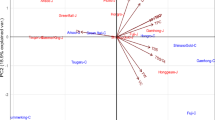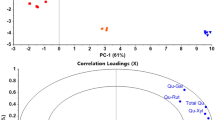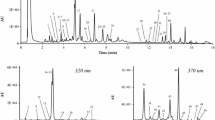Abstract
The objective of this study was to explore the utility of the phenolic pattern (1) to differentiate or associate between cultivars with a different or same genetic background respectively and (2) to assess some important quality traits (color, disease resistance, and browning) in apple fruit. A unique set of cultivars/candivars occurring in Belgium were selected for this survey. It was possible to segregate the studied apple cultivars/candivars into three clusters: red-flesh apple candivars, classic/new cultivars and candivars and heritage apple cultivars. It was found that the heritage apple varieties selected for their disease resistance and cultivated under organic agricultural practice demonstrate a remarkable different phenolic profile. Furthermore, it was found that the phenolic makeup of the peel could suggest the genetic relationships among the apple cultivars. In conclusion, the knowledge of the phenolic profile could be a useful instrument in breeding programs to identify apples with better quality traits, processing characteristics and health-benefiting effects.





Similar content being viewed by others
References
Balázs, A., Tóth, M., Blazics, B., Héthelyi, É., Szarka, S., Ficsor, E., et al. (2012). Investigation of dietary important components in selected red fleshed apples by GC-MS and LC-MS. Fitoterapia, 83, 1356–1363.
Ceymann, M., Arrigoni, E., Schärer, H., Nising, A. B., & Hurrell, R. F. (2012). Identification of apples rich in health-promoting flavan-3-ols and phenolic acids by measuring the polyphenol profile. Journal of Food Composition and Analysis, 26, 128–135.
Cornille, A., Gladieux, P., Smulders, M. J. M., Roldán-Ruiz, I., Laurens, F., Le Cam, B., et al. (2012). New insight into the history of domesticated apple: Secondary contribution of the European wild apple to the genome of cultivated varieties. PLoS Genetics, 8, 1–13.
Cuthbertson, D., Andrews, P. K., Reganold, J. P., Davies, N. M., & Lange, B. M. (2012). Utility of metabolomics toward assessing the metabolic basis of quality traits in apple fruit with an emphasis on antioxidants. Journal of Agricultural and Food Chemistry, 60, 8552–8560.
De Paepe, D., Servaes, K., Noten, B., Diels, L., De Loose, M., Van Droogenbroeck, B., et al. (2013). An improved mass spectrometric method for identification and quantification of phenolic compounds in apple fruits. Food Chemistry, 136, 368–375.
Espley, R. V., Hellens, R. P., Putterill, J., Stevenson, D. E., Kutty-Amma, S., & Allan, A. C. (2007). Red colouration in apple fruit is due to the activity of the MYB transcription factor, MdMYB10. The Plant Journal, 49, 414–427.
Hamauzu, Y. (2006). Role and evolution of fruit phenolic compounds during ripening. Stewart Postharvest Review, 2, 1–7.
Harrison, N., & Harrison, J. R. (2011). On the evolutionary history of the domesticated apple. Nature Genetics, 43, 1043–1044.
Honda, C., Kotoda, N., Wada, M., Kondo, S., Kobayashi, S., Soejima, J., et al. (2002). Anthocyanin biosynthetic genes are coordinately expressed during red coloration in apple skin. Plant Physiology and Biochemistry, 40, 955–962.
Iacopini, P., Camangi, F., Stefani, A., & Sebastiani, L. (2010). Antiradical potential of ancient Italian apple varieties of Malus x domestica Borkh. in a peroxynitrite-induced oxidative process. Journal of Food Composition and Analysis, 23, 518–524.
Kellerhals, M., Szalatnay, D., Hunziker, K., Duffy, B., Nybom, H., Ahmadi-Afzadi, M., et al. (2012). European pome fruit genetic resources evaluated for disease resistance. Trees, 26, 179–189.
Khan, S. A., Chibon, P. Y., de Vos, R. C. H., Schipper, B. A., Walraven, E., Beekwilder, J., et al. (2012). Genetic analysis of metabolites in apple fruits indicates an mQTL hotspot for phenolic compounds on linkage group 16. Journal of Experimental Botany, 63, 2895–2908.
Khanizadeh, S., Groleau, Y., Levasseur, A., Carisse, O., & Rekika, D. (2006). ‘SuperMac’apple. HortScience, 41, 1159–1161.
Lammerts van Bueren, E. T., & Myers, J. R. (2011). Organic crop breeding. Hoboken: Wiley, Inc.
Lateur, M., & Populer, C. (1994). Screening fruit tree genetic resources in Belgium for disease resistance and other desirable characters. In H. Schmidt & M. Kellerhals (Eds.), Progress in temperate fruit breeding (pp. 425–431). Dordrecht: Kluwer Academic Publishers.
Le Bourvellec, C., Le Quéré, J.-M., Sanoner, P., Drilleau, J.-F., & Guyot, S. (2004). Inhibition of apple polyphenol oxidase activity by procyanidins and polyphenol oxidation products. Journal of Agricultural and Food Chemistry, 52, 122–130.
Mayr, U., Michalek, S., Treutter, D., & Feucht, W. (1997). Phenolic compounds of apple and their relationship to scab resistance. Journal of Phytopathology, 145, 69–75.
Nyamundanda, G., Brennan, L., & Gormley, I. C. (2010). Probabilistic principal component analysis for metabolomic data. BMC Bioinformatics, 11, 571–580.
Petkovsek, M., Slatnar, A., Stampar, F., & Veberic, R. (2010). The influence of organic/integrated production on the content of phenolic compounds in apple leaves and fruits in four different varieties over a 2-year period. Journal of the Science of Food and Agriculture, 90, 2366–2378.
Richards, C. M., Gayle, M. V., Reilley, A. A., Henk, A. D., Lockwood, D. R., Reeves, P. A., et al. (2009). Genetic diversity and population structure in Malus sieversii, a wild progenitor species of domesticated apple. Tree Genetics & Genomes, 5, 333–347.
Rupasinghe, H. P. V., Wang, L., Pitts, N. L., & Astatkie, T. (2009). Baking and sensory characteristics of muffins incorporated with apple skin powder. Journal of Food Quality, 32, 685–694.
Singh, A., Singh, K. P., Rajwar, G. S., & Singh, U. P. (2010). Phenolic acid content—a criterion for selection of resistant apple cultivars against Podosphaera leucotricha (Ell. and Ev.) Salmon. Phytopathology And Plant Protection, 43, 1138–1143.
Slatnar, A., Petkovsek, M. M., Halbwirth, H., Stampar, F., Stich, K., & Veberic, R. (2010). Response of the phenylpropanoid pathway to Venturia inaequalis infection in maturing fruit of ‘Braeburn’ apple. Journal of Horticultural Science & Biotechnology, 85, 465–472.
Slatnar, A., Petkovsek, M. M., Halbwirth, H., Stampar, F., Stich, K., & Veberic, R. (2012). Polyphenol metabolism of developing apple skin of a scab resistant and a susceptible apple cultivar. Trees, 26, 109–119.
Son, K. M., Kwon, S. I., & Choi, C. (2012). Inbreeding, coancestry, and founding clones of apple cultivars released from Korea. Horticulture, Environment, and Biotechnology, 53, 404–409.
Stracke, B. A., Rüfer, C. E., Bub, A., Seifert, S., Weibel, F. P., Kunz, C., et al. (2010). No effect of the farming system (organic/conventional) on the bioavailability of apple (Malus domestica Bork., cultivar Golden Delicious) polyphenols in healthy men: a comparative study. European Journal of Nutrition, 49, 301–310.
Sun, J., Cao, X., Bai, W., Liao, X., & Hu, X. (2010). Comparative analyses of copigmentation of cyanidin 3-glucoside and cyanidin 3-sophoroside from red raspberry fruits. Food Chemistry, 120, 1131–1137.
Takos, A. M., Jaffe, F. W., Jacob, S. R., Bogs, J., Robinson, S. P., & Walker, A. R. (2006). Light-induced expression of a MYB gene regulates anthocyanin biosynthesis in red apples. Plant Physiology, 142, 1216–1232.
Telias, A., Lin-Wang, K., Stevenson, D. E., Cooney, J. M., Hellens, R. P., Allan, A. C., et al. (2011). Apple skin patterning is associated with differential expression of MYB10. BMC Plant Biology, 11, 93–106.
Tikunov, Y. M., Laptenok, S., Hall, R. D., Bovy, A., & de Vos, R. C. H. (2012). MSClust: a tool for unsupervised mass spectra extraction of chromatography-mass spectrometry ion-wise aligned data. Metabolomics, 8, 714–718.
Treutter, D. (2005). Significance of flavonoids in plant resistance and enhancement of their biosynthesis. Plant Biology, 7, 581–591.
Valavanidis, A., Vlachogianni, T., Psomas, A., Zovoili, A., & Siatis, V. (2009). Polyphenolic profile and antioxidant activity of five apple cultivars grown under organic and conventional agricultural practice. International Journal of Food Science & Technology, 44, 1167–1175.
van den Berg, R. A., Hoefsloot, H. J. C., Westerhuis, J. A., Smilde, A. K., & van der Werf, M. J. (2006). Centering, scaling, and transformations: improving the biological information content of metabolomics data. BMC Genomics, 7, 142–156.
van der Werf, M. J., Jellema, R. H., & Hankemeier, T. (2005). Microbial metabolomics: Replacing trial-and-error by the unbiased selection and ranking of targets. Journal of Industrial Microbiology and Biotechnology, 32, 234–252.
van Nocker, S., Berry, G., Najdowski, J., Michelutti, R., Luffman, M., Forsline, P., et al. (2012). Genetic diversity of red-fleshed apples (Malus). Euphytica, 185, 281–293.
van Treuren, R., Kemp, H., Ernsting, G., Jongejans, B., Houtman, H., & Visser, L. (2010). Microsatellite genotyping of apple (Malus × domestica Borkh.) genetic resources in the Netherlands: application in collection management and variety identification. Genetic Resources and Crop Evolution, 57, 853–865.
Vanzo, A., Jenko, M., Vrhovsek, U., & Stopar, M. (2013). Metabolomic profiling and sensorial quality of ‘Golden Delicious’, ‘Liberty’, ‘Santana’, and ‘Topaz’ apples grown using organic and integrated production systems. Journal of Agricultural and Food Chemistry, 61, 6580–6587.
Zhao, X., & Rajashekar, C. B. (2006). Does Organic Production Enhance Phytochemical Content of Fruit and Vegetables? Current Knowledge and Prospects for Research. HortTechnology, 16, 449–456.
Acknowledgments
The authors are grateful to Annemarie Auwerkerken (Better3Fruit, Rillaar), Tom Deckers and Jef Vercammen (PC Fruit, Kerkom, Belgium) for their insightful suggestions, to Marc Lateur (CRA-W, Gembloux, Belgium) for assistance in selecting cultivars. Special thanks are extended to Ann Gomand (‘PC Fruit’), Luc Goossens (‘Lombarts Calville), Bart Dequidt for the delivery of plant material.
Conflict of interest
The all authors declared that they have no conflict of interest in the submission of this manuscript.
Compliance with Ethics Requirements
This article does not contain any studies with human participants or animals performed by any of the authors.
Author information
Authors and Affiliations
Corresponding author
Electronic supplementary material
Below is the link to the electronic supplementary material.
Rights and permissions
About this article
Cite this article
De Paepe, D., Valkenborg, D., Noten, B. et al. Variability of the phenolic profiles in the fruits from old, recent and new apple cultivars cultivated in Belgium. Metabolomics 11, 739–752 (2015). https://doi.org/10.1007/s11306-014-0730-2
Received:
Accepted:
Published:
Issue Date:
DOI: https://doi.org/10.1007/s11306-014-0730-2




